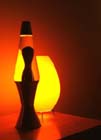
Purpose
To demonstrate the effects of salt on oil by creating a "lava lamp" in a cup.
Additional information
Lava lamps have been around since 1963, when Englishman Edward Craven-Walker invented the first version of the trippy contraption. For those unfamiliar with Lava Lamps, they were the staple decor of apartments in the 60's. The "lamp" is comprised of a slightly triangular glass jar that is filled with colored liquid and a glob of liquid "lava" that would magically float, dance, and break apart when the lamp was turned on.
Sponsored Links
Required materials
- Salt (1 or more teaspoons)
- Tap water
- 1/4 cup of olive or vegetable oil
- Food coloring (red, green, blue, and any other color you like)
- Large clear glass
- Eye dropper (optional if your food coloring is not in a dropper)
Estimated Experiment Time
About 5 to 10 minutes
Step-By-Step Procedure
- 1. Fill the glass with tap water, about 2/3rds of the way. You'll need to add the oil later, so make sure there is enough room left in the cup.
- 2. Pour the oil into the glass slowly. The oil will float on top of the water (don't try to mix it in).
- 3. Add several drops of different food coloring to the water and oil.
- 4. Slowly sprinkle 1 teaspoon of salt into the glass. Observe what happens to the oil and water mixture. Groovy!
Note
Add several drops of different food coloring for the best effects. It's like a lava lamp in your glass!
Observation
What happens to the liquid when water is added? What would happen if you add another teaspoon of salt? What if you add SEVERAL teaspoons of salt (give it a try and see)? How do you think another substance would affect the oil and water? What if you tried using sugar, sand, or even coffee grinds?
Result
Oil is lighter than the water, which is why it floats at the top. This is similar to what happens during oil spills on the ocean. The salt, on the other hand, is heavier than the oil. When it's added to the glass the salt begins to sink to the bottom of the glass, taking some of the oil with it. When the salt finally dissolves, the oil is released and again floats to the surface above the water. This is a similar concept to how the Lava Lamp functions. The glob in the lamp is comprised of a wax that rises and dances as it's heated from below. It expands as it becomes less dense than the liquid around it, causing the trippy sequence that was the staple of the 60's.
Sponsored Links
Take a moment to visit our table of Periodic Elements page where you can get an in-depth view of all the elements,
complete with the industry first side-by-side element comparisons!